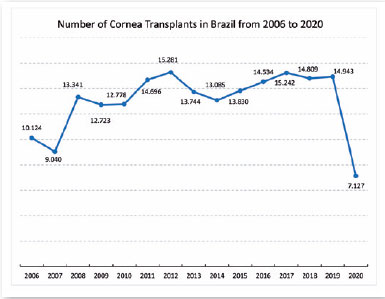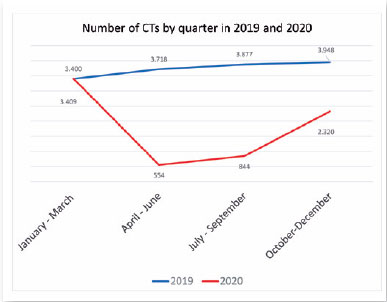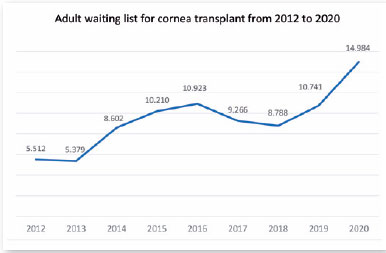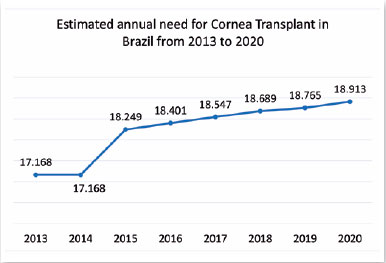Henrique Bosso1; Henrique Sanctis Santarem1; Bruno Oliveira Pesquero3; Evandro Portaluppe Bosso4
DOI: 10.17545/eOftalmo/2022.0014
ABSTRACT
PURPOSE: Cornea transplantation is one of the most widely performed transplants worldwide. However, owing to several intrinsic factors, performing this procedure is challenging in Brazil. As a consequence of this, there has been a considerable increase in the number of patients on the waiting list. Furthermore, this issue was further exacerbated by the occurrence of the COVID-19 pandemic, which culminated in the temporary suspension of elective cornea transplants at numerous hospitals. The purpose of the present study was to analyze cornea transplant activity from 2006 to 2020 in all regions of Brazil and to elucidate the impacts of the COVID-19 outbreak on cornea donation and transplantation activities in Brazil.
METHODS: Epidemiological data were collected from the Brazilian Transplant Registry, for the years 2006 to 2020, published by the Associação Brasileira de Transplantes de Órgãos.
RESULTS: A significant decrease in the number of cornea transplants was observed in 2020 when compared with those in previous years, which highlighted that the number of cornea transplants has reduced performed in the last fifteen years. This has resulted in an increase in the waiting list and in the estimated annual need for cornea transplants.
CONCLUSION: The Covid19 pandemic has led to a significant decrease in the number of cornea transplants from the second quarter of 2020, whereas the number of patients waiting for this procedure has increased during the same period.
Keywords: Coronavirus; Pandemic; Cornea transplantation
RESUMO
OBJETIVOS: O transplante de córnea (TC) é um dos transplantes mais realizados em todo mundo. Todavia, diversos fatores intrínsecos dificultam sua realização no Brasil, resultando em um elevado número de pacientes na fila de espera. Ademais, associa-se a tal dificuldade a pandemia de COVID-19, que culminou na suspensão temporária dos transplantes eletivos de córnea em diversos locais. O objetivo é analisar a atividade de transplante de córnea nos anos de 2006 a 2020 em todas as regiões do Brasil e o impacto do surto de COVID-19 em atividades de doação e transplante de córnea no Brasil.
MÉTODOS: Foram colhidos dados epidemiológicos no Registro Brasileiro de Transplantes, publicado pela Associação Brasileira de Transplantes de Órgãos dos anos de 2006 até 2020.
RESULTADOS: Em 2020 houve uma importante redução no número de transplante de córnea quando comparado aos anos anteriores, refletindo no menor número de transplante de córnea realizados dos últimos 15 anos, o que provocou um aumento de na fila de espera e na necessidade anual estimada de transplante de córnea.
CONCLUSÃO: Impactado pela atual pandemia, o número de transplante de córnea decresceu significativamente a partir do segundo trimestre de 2020, enquanto o número de pacientes esperando por este procedimento aumentou neste mesmo período.
Palavras-chave: Coronavírus; Pandemia; Transplante de Córnea.
INTRODUCTION
Since 1905, when it was first performed by Edward Zirm, cornea transplantation (CT) has established itself as one of the most widely performed and most successful allogeneic transplants worldwide1. Particularly for diseases that progress with the loss of cornea transparency, CT is performed to restore the patient’s vision and, positively impact the individual’s social and psychological well-being2. Patients with the following specific clinical criteria are accepted as CT recipients: keratoconus, bullous keratopathy, keratoglobus, leukomas, Fuchs endothelial dystrophy and other corneal dystrophies, interstitial keratitis, pellucid marginal degeneration, corneal burn, congenital corneal anomalies, and secondary or late graft failure3. In addition, urgent CT is needed in cases of primary graft failure, corneal ulcers that do not respond to clinical treatment, imminent corneal perforation, and recipients younger than 7 years who present corneal opacity 4.
In Brazil, CT is regulated by the Sistema Nacional de Transplantes (SNT), linked to the Ministry of Health2. The SNT establishes that the cornea needs to be removed within 6 hours after cardiac arrest, clinicians not should not make decisions according to brain death criteria. Furthermore, to perform the donation after cardiac arrest, the family must be consulted and express the desire for the donation. The State Transplant Center is then notified, and the collection, storage, and distribution of the cornea are performed.
Currently, the availability of corneas does not meet the demand for donation5. Proof of this is that there are approximately 12.7 million patients waiting for a cornea transplant worldwide; however, only 1 cornea is available for every 70 cornea needed1. As a result, the number of people on the waiting list for corneas is increasing annually. This increase depends on not only the existence of a potential donor cadaver but also a series of factors, such as socio-educational level, cultural standards, stimulus programs, adequate legislation, and medical infrastructure for the collection and correct use of organs and tissues6. These factors help to explain not only the low number of donations, but also the discrepancies between regions and countries.
At the end of 2019, an outbreak of coronavirus infection in the city of Wuhan, Hubei province, People’s Republic of China, was announced to the World Health Organization, with the etiological agent SARS-COV-27. Since then, the propagation of this outbreak has been exponential, occurring mainly through close contact or by fomites, with an incubation time ranging from 2 to 14 days8. In Brazil, the first case of infection by COVID-19 was confirmed on February 26, 2020. Since then, according to the Oswaldo Cruz Foundation, the country’s public and private health systems have suffered several collapses due to the continued growth of transmission, cases, and deaths. In addition, the high occupancy rates of wards and beds in intensive care units are affecting the entire health system in the country, causing a decrease in consultations and elective surgeries9.
With regard to organ and tissue transplants, the Associação Brasileira de Transplantes de Órgãos (ABTO) proposed continuing these procedures, with the exception of cornea and pancreas transplants, which could be postponed under certain circumstances10. Therefore, for example, on March 22, 2020, the Health Department of the State of São Paulo announced the suspension of elective cornea transplants throughout the state.
In Brazil, analyzing in terms of both absolute and relative numbers, the number of studies that have attempted to elucidate the processes and mechanisms involved in CT are relatively few.
The purposes of this study were to analyze CT activity from 2006 to 2020 in all regions of Brazil and to elucidate the impacts of the COVID-19 outbreak on donation and CT activities in Brazil.
METHODS
This is a narrative review, tracing the epidemiological profile of CT performed in Brazil from 2006 to 2020. The study began with a review of the theoretical background, searching the online databases: PubMed, sciELO and Medline, and using as keywords: “cornea transplant” AND “organ transplant” AND “epidemiology” in the last 10 years. Epidemiological data were collected from the Brazilian Transplant Registry, published by the ABTO, from 2006 to 2020. The present study is risk free, as it is a narrative review and no names or any personal information will be published.
RESULTS
Number of cornea transplants
In 2020, a significant reduction was observed in the absolute number of CTs of 52.31% when compared to the previous year. A total of 7127 corneas were transplanted, the lowest number in the entire time series considered in this study.
However, each Brazilian region presented a different dynamic. In 2020, the Southeast region showed a reduction of 53.75% compared to the previous year. The South region, in turn, had a reduction of 58.95%. However, the Northeast region showed a reduction of 47.92%. In the Midwest region, there was a reduction of 47.43%. The North region showed a reduction of 44.23%, this being the region with the smallest reduction in the absolute number of CTs from 2019 to 2020.
Number of cornea transplants per quarter
We compared the number of CTs per quarter for the years 2019 and 2020 across Brazil. In the first quarter of 2019, 3400 CTs were performed, whereas in the same period of 2020, 3409 CTs were performed, representing an increase of 0.26%. In the second quarter of 2019, 3718 CTs were performed, whereas in the same period of 2020, the number of CTs was 554, representing a decrease of 85.1%. In the third quarter of 2019, 3877 CTs were performed, whereas in 2020, only 844 were performed, a drop of 78.24%. Finally, in the last quarter, in 2019, 3948 CT were performed and, in 2020, 2320 were conducted, showing a decrease of 41.24%.
Waiting list
There was a reduction in the waiting list for adult patients of 2.42% from 2012 to 2013. From 2013 to 2014, there was an increase in the number of people waiting for CT, of 59.91%. This increase is mainly attributable to the increase in diagnosis and increase of individual waiting for CT, since in this same period, there was a decrease of only 4.79% of CT performed in Brazil. From 2014 to 2015, the increase was 18.69%. From 2015 to 2016, there was an increase of 6.98%. There was a reduction of 15.17% from 2016 to 2017. Furthermore, a reduction of 5.16% was observed from 2017 to 2018. In 2018, the waiting list increased again, and from 2018 to 2019, there was an increase of 22.22%. From 2019 to 2020, there was a significant increase of 39.5%, reflecting the impact of the COVID-19 pandemic on the number of cornea transplants performed throughout Brazil.
Estimated annual need for cornea transplant
The estimated annual need for CT remained static from 2013 to 2014. From 2014 to 2015, there was an increase of 6.2%. From 2015 to 2016, there was an increase of 0.83%. From 2016 to 2017, the increase was 0.79%. From 2017 to 2018, the increase was 0.76%. From 2018 to 2019, the increase was 0.4%. Finally, from 2019 to 2020, there was an increase of 0.78%.





DISCUSSION
There are several threats to transplants in general, including an emerging infectious disease. Since the 1980s, there have been a number of emerging viral diseases, including HIV in the second half of the 1980s, SARS-CoV, the West Nile virus, the H1N1 pandemic influenza, Zikavirus, Ebola, and now the COVID-19 pandemic, caused by SARS-CoV-211-14.
In Brazil, a significant reduction was observed in the number of transplants in 2020, including cornea transplants, which decreased by 19.2% when compared to the same period of the previous year. The second quarter of 2020 (April to June) was the period with the largest decrease when compared to the previous year, of 48.5%. This period corresponds to the arER of the pandemic in Brazil, when there was a paucity of information about the virus and how to manage the pandemic through public health policies.
Despite the severity of the symptoms caused by the virus and its repercussion, there is still no consensus on how to best treat the patient. To date, there is much controversy regarding the best drug treatment, and basic support and a specific assessment of each case are necessary8.
Transplantation programs had to be modified in several countries, and it was necessary to develop a clinical screening tool for donors. A tool developed by the University Health Network (Canada) is based on 4 sessions: (A) whether the institution is a referral hospital for critically ill patients infected with COVID-19; (B) whether the donor has been infected with COVID-19 in the last 14 days; (C) whether the donor has had previous exposure to COVID-19, such as travel to endemic areas or contamination in the last 3 months; and (D) whether the patient presents clinical symptoms of a flu-like syndrome. Based on the response to these four sessions, the donor is classified as high risk, moderate-high risk, moderate-low risk, or very low risk for donation14.
In addition to the difficulties and risks for carrying out the transplant in relation to the hospital scenario in the face of COVID-19, the risks to which transplant patients are exposed should be considered, due to the greater vulnerability of these patients, related to chronic use of immunosuppressants and previous comorbidities. However, there was an increase in the number of severe cases among transplant patients compared to international cohorts of general populations. Severe cases require invasive mechanical ventilation, and result in higher mortality rates15.
In Brazil, the main indication for CT is keratoconus. However, there are variations between different regions and centers of reference. Other leading indications for CT include: bullous pseudophakic keratopathy, rejection, primary failure, Fuchs dystrophy and other corneal dystrophies16,17.
From 2016, the number of people on the waiting list for CT was decreasing, but this was reversed in 2019 with an increase of 22.22% over the previous year. This increase in the waiting list was even more significant from 2019 to 2020 (39.5%), possibly due to the impacts of the COVID-19 pandemic on various transplant centers throughout Brazil, leading to a reduction in the number of transplants performed, and consequently, an increase in the waiting list.
The great hope for reducing the pandemic and for the future of transplants is vaccination against COVID-19, which has been carried out, albeit slowly, since January 2021. To ensure a better immune response, inactivated vaccines should, ideally, be applied at least fourteen days before CT. However, the Intervention Coordination linked to the National Supplementary Health Agency advises that there is no need for a time interval between vaccination and CT transplantation, either for the donor or for the recipient, and indicates vaccination is indicated even for immunosuppressed patients and after CT18.19.
Since 2007, Brazil has been showing a significant increase in the number of CTs performed in all Brazilian regions, thanks to the intense activity in raising population awareness and structuring the teams responsible for collecting and donating corneas. However, in 2020 there was a significant decrease in the number of CTs performed when compared to previous years. This study shows that this decrease occurred mainly in the second quarter, corresponding to the start of the pandemic in the country, when little was known about the virus and how to properly control it through public health policies. In regional terms, the decrease in transplants was proportionally greater in the South region. There was also a significant increase in the number of individuals waiting for CT.
Vaccination provides as an essential ally against the pessimistic findings of the current work. However, with the slow pace of vaccination, the lack of adequate public policies and the emergence of new variants of the virus, it is very likely that the difficulty in carrying out the CT will extend throughout 2021. It is also worth noting that as the pandemic continues, more epidemiological studies will be needed in the coming years, to analyze the real impacts of the pandemic on CT.
REFERENCES
1. Chaurasia S, Sharma N, Das S. COVID-19 and eye banking. Indian J Ophthalmol. 2020;68(6):1215.
2. Almeida HG, Hida RY, Kara-Junior N. Trends in corneal transplantation from 2001 to 2016 in Brazil. Arq Bras Oftalmol. 2018;81(6):529-38.
3. Superintendência do Complexo Regulador em Saúde de Goiás, Manual do Receptor para o Transplante de Córnea. [acesso em 29 mar 2021]. Disponível em: https://www.saude.go.gov.br/files/scrs/gerencia-transplantes/MANUALDORECE
4. Secretaria de Assistência à Saúde do Ministério da Saúde do Brasil. Portaria GM no 3.407 de 5 de agosto de 1998. Diário Oficial da União.
5. Rezende LB, Veloso C, Pereira JR, de Oliveira Rezende L. Doação de órgãos no Brasil: uma análise das campanhas governamentais sob a perspectiva do marketing social. ReMark. 2015;14(3):362-76.
6. Pessini L, de Barchifontaine CD. Problemas atuais de bioética. Edições Loyola; 1997.
7. Zhu N, Zhang D, Wang W, Li X, Yang B, Song J, Zhao X, Huang B, Shi W, Lu R, Niu P, Zhan F, Ma X, Wang D, Xu W, Wu G, Gao GF, Tan W, China Novel Coronavirus Investigatin and Research Team. A novel coronavirus from patients with pneumonia in China, 2019. N Engl J Med. 2020;382(8):727-733.
8. Croda JH, Garcia LP. Resposta imediata da Vigilância em Saúde à epidemia da COVID-19.
9. Fundação Oswaldo Cruz [acesso em 28 mar 2021] Disponível em: <https://portal.fiocruz.br/noticia/observatorio-covid-19-aponta-maior-colapso-sanitario-e-hospitalar-da-historia-do-brasil
10. Associação Brasileira de Transplantes de Órgãos [acesso em 28 mar 2021]. Disponível em: https://site.abto.org.br
11. Levi ME, Kumar D, Green M, Ison MG, Kaul D, Michaels MG, Morris MI, Schwartz BS, Echenique IA, Blumberg EA, AST ID Community of Practice. Considerations for screening live kidney donors for endemic infections: a viewpoint on the UNOS policy. Am J Transplant. 2014;14(5):1003-11.
12. Kaul DR, Mehta AK, Wolfe CR, Blumberg E, Green M. Ebola virus disease: implications for solid organ transplantation. Am J Transplant. 2015;15(1):5-6.
13. Blumberg EA, Fishman JA. Zika virus in transplantation: emerging infection and opportunities. Am J Transplant. 2017;17(3):599-600.
14. Kumar D, Manuel O, Natori Y, Egawa H, Grossi P, Han SH, et al. COVID-19: a global transplant perspective on successfully navigating a pandemic. Am J Transplant. 2020;20(7):1773-9.
15. Guan WJ, Liang WH, Zhao Y, Liang HR, Chen ZS, Li YM, Liu XQ, Chen RC, Tang CL, Wang T, Ou CQ, Li L, Chren PY, Sang L, Wang W, Li JF, Li CC, Ou LM, Cheng B, Xiong S, Ni ZY, Xiang J, Hu Y, Liu L, Shan H, Lei CL, Peng YX, Wei L, Liu Y, Hu YH, Peng P, Wang JM, Liu JY, Chrn Z, Li G, Zhreng ZJ, Qiu SQ, Luo J, Ye CJ, Zhu SY, Cheng LL, Ye F, Li SY, Zheng JP, Zhang NF, Zhong NS, He JX, China Medical Treatment Expert Group for COVID-19. Comorbidity and its impact on 1590 patients with COVID-19 in China: a nationwide analysis. Eur Respir J. 2020;55(5):2000547.
16. Plano Nacional de Operacionalização da Vacinação Contra COVID-19 [acesso em 28 mar 2021]. Disponível em: https://www.conasems.org.br/wp-content/uploads/2021/04/PLANONACIONALDEVACINACAOCOVID19_ED06_V3_28.04.pdf
17. Association for the Study of Liver Diseases [Acesso em 29 mar 2021]. Disponível em: https://www.aasld.org/about-aasld/covid-19-and-liver
18. Neves RC, Boteon JE, Santiago AP. Indicações de transplante de córnea no Hospital São Geraldo da Universidade Federal de Minas Gerais. Rev Bras Oftalmol. 2010;69:84-8.
19. Teixeira MF, Almeida Jr GC, Rodrigues ML, Kamimoto PS, Kashiwabuchi LK. Resultados e indicações de ceratoplastias penetrantes realizadas por médicos em treinamento, num país em desenvolvimento. Arq Bras Oftalmol 2001;64(6):557-61.
AUTHOR’S INFORMATION



Funding: No specific financial support was available for this study
Conflict of interest: None of the authors have any potential conflict of interest to disclose
Received on:
March 22, 2022.
Accepted on:
September 11, 2022.